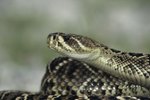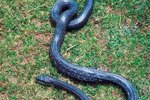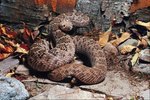
Approximately 45 native snake species inhabit Florida. Located in the western end of the panhandle, Pensacola is home to most of these species; most of the region’s snakes are harmless to humans, but six species are capable of delivering a venomous bite. Additionally, thanks to the state's warm climate, several invasive species have established residency as well.
Venomous Snakes
Four venomous snakes live statewide: diamondback rattlesnakes (Crotalus adamanteus), pigmy rattlesnakes (Sistrurus miliarius), cottonmouths (Agkistrodon piscivorous) and coral snakes (Micrurus fulvius). Pensacola is also within the range of the southern copperhead (Agkistrodon c. contortrix). Timber rattlesnakes (Croatlus horridus) are occasionally observed in the panhandle, though they are not common. Cottonmouths, copperheads and rattlesnakes are pit vipers equipped with long, folding fangs, while coral snakes -- cousins of the cobras, mambas and kraits -- have small, fixed fangs.
Aquatic and Semi-Aquatic Snakes
Garter and ribbon snakes (Thamnophis sp.), inhabit the borders of ponds, streams and marshes; sometimes they venture into backyards and gardens in pursuit of frogs, worms and slugs. Mud (Farancia abacura) and rainbow (F. erytrogramma) snakes live in rivers and streams, primarily consuming elongate salamanders and eels, respectively. Three species of crayfish and queen snake (Regina sp.) are dedicated predators of their namesake crustacean. Six true watersnake species (Nerodia sp.) exhibit a diversity of natural histories and feed on varying proportions of amphibians and fish.
Large Constrictors
Rat snakes (Pantherophis sp.), pine snakes (Pituophis melanoleucus) and kingsnakes (Lampropeltis getula ssp.) are the largest constricting snakes in the Pensacola area. Pine snakes primarily prey on rodents, sometimes pursuing them into their burrows. Rat snakes are excellent climbers; in addition to rodents, they hunt for birds, nestlings and eggs. Kingsnakes eat a wide variety of prey, including rodents, lizards and snakes. Of the three, pine snakes prefer the driest habitats; rat snakes prefer forests and suburban areas; while kingsnakes usually inhabit areas where two different habitats meet. Large rat snakes may approach 7 feet in length, while large pine or kingsnakes only reach about 5 feet.
High Speed Hunters
Florida is home to several snakes that use their speed to catch lizards, birds, rodents and other snakes. Black racers (Coluber constrictor) are solid black dorsally, while the pattern of coachwhips (Masticophis sp.) changes along their length, sometimes forming a braided pattern. Most whipsnakes (Masticophis sp.) have longitudinal stripes. Indigo snakes are somewhat similar, but attain larger sizes and eat larger prey, including other snakes. Indigo snakes frequently inhabit gopher tortoise burrows.
Small, Terrestrial Species
Many species inhabit the leaf litter of the Pensacola region. Ringneck snakes (Diadophis punctatus), use their bright orange bellies to warn predators of their pungent musk. Brown (Storeria dekayi) and red-bellied (S. occipitomaculata) snakes hunt for snails and slugs and often hide under logs, rocks and other debris. Crowned snakes (Tantila sp.) are pencil-sized serpents that primarily consume centipedes and other invertebrates.
Unique Species
Hognose snakes (Heterodon sp.) flatten their neck and hiss when threatened; if this is not enough to dissuade a predator, they roll over and feign death. The short-tailed kingsnake (Lampropeltis extenuata) is much different from other kingsnakes, having diverged from them about 6 million years ago. They are thought to eat only one type of snake in the wild: crowned snakes. The rough green snake (Opheodyrs aestivus) reaches about 3 feet in length and is an insectivorous species that hunts in trees and shrubs.
Introduced Species
The warm climate of Florida allows many released or escaped pets to survive, in some cases, breeding populations have developed. Though researchers are still trying to document specific ranges for these introduced species, statewide, Florida has three introduced snakes: boa constrictors (Boa constrictor ssp.), Burmese pythons (Python bivvitattus) and African rock pythons (Python sebae).
References
- Florida Museum of Natural History: List of Florida Snakes
- Florida Backyard Snakes: Florida Non-Venomous Snakes
- Zootaxa: Systematics of the Common Kingsnake (Lampropeltis Getula; Serpentes: Colubridae) and the Burden of Heritage in Taxonomy
- Savannah River Ecology Laboratory: Ring
- Bulletin of the Chicago Herp Society: A Review and Synthesis of Existing Literature on Rainbow Snakes, Farancia Erytrogramma
- Florida Museum of Natural History: Southern Copperhead
- Florida Museum of Natural History: Eastern Coral Snake
- Florida Museum of Natural History: Eastern Rat Snake
- US Fish and Wildlife Service: Eastern Indigo Snake
- Savannah River Ecology Laboratory: Southern Hognose
Photo Credits
-
Tom Brakefield/Stockbyte/Getty Images



